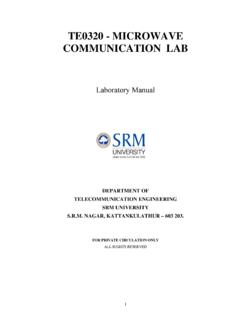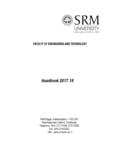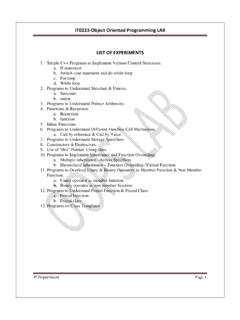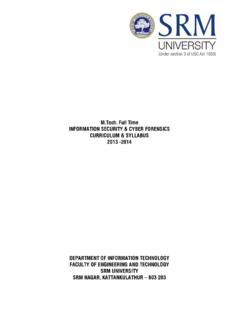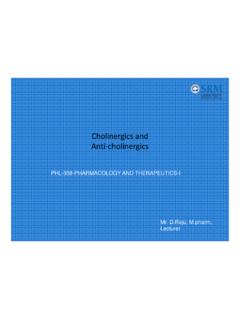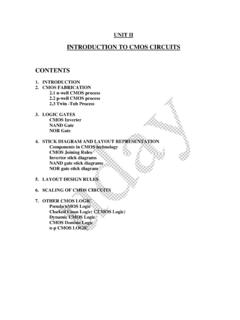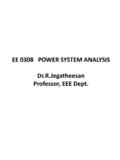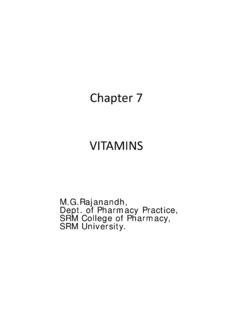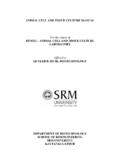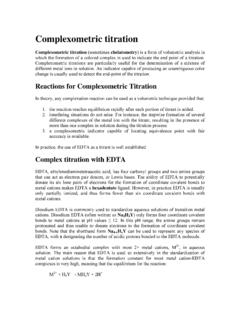Transcription of DEPARTMENT OF ELECTRICAL AND ELECTRONICS …
1 1 EE0314- POWER ELECTRONICS LAB REFERENCE MANUAL SEMESTER VI DEPARTMENT OF ELECTRICAL AND ELECTRONICS engineering SRM university kattankulathur - 603203 2 EXPT. NO. 1 : Pre lab Questions Single Phase Half Converter 1. What is the delay angle control of converters? 2. What is natural or line commutation? 3. What is the principle of phase control? 4. What is extinction angle? 5. Can a freewheeling diode be used in this circuit and justify the reason? 3 SINGLE PHASE HALF CONTROLLED BRIDGE RECTIFIER Aim: To study the operation of single phase half controlled converter using R and RL load and to observe the output waveforms.
2 Apparatus required: 1. Power thyristors 2. Rheostat 3. CRO 4. Transformer (1-phase) 230V/24V 5. Connection wires Single Phase Half Controlled Bridge Rectifier: Circuit Diagram 4 Model Graph: Observation Table: Serial No. Triggering angle degree Output voltage Vo (volt) (measured) Time period(ms) 1 2 3 Procedure: 1. Make the connections as per the circuit diagram. 2. Connect CRO and voltmeter across the load. 3. Keep the potentiometer at the minimum position. 4. Switch on the step down ac source. 5. Check the gate pulses at G1-K1 & G2-K2, respectively. 6. Observe the wave form on CRO and note the triggering angle and 7.
3 Note the corresponding reading of the voltmeter. Also note the value of Maximum amplitude Vm from the waveform. 5 8. Set the potentiometer at different positions and follow the step given in (6) for every position. 9. Tabulate the readings in the observation column. Theory: A semi converter uses two diodes and two thyristors and there is a limited control over the level of dc output voltage. A semi converter is one quadrant converter. A one-quadrant converter has same polarity of dc output voltage and current at its output terminals and it is always positive. It is also known as two-pulse converter.
4 Figure shows half controlled rectifier with R load. This circuit consists of two SCRs T1 and T2, two diodes D1 and D2. During the positive half cycle of the ac supply, SCR T1 and diode D2 are forward biased when the SCR T1 is triggered at a firing angle t = , the SCR T1 and diode D2 comes to the on state. Now the load current flows through the path L - T1- R load D2 - N. During this period, we output voltage and current are positive. At t = , the load voltage and load current reaches to zero, then SCR T1 and diode D2 comes to off state since supply voltage has been reversed. During the negative half cycle of the ac supply, SCR T2 and diode D1 are forward biased.
5 When SCR T2 is triggered at a firing angle t = + , the SCR T2 and diode D1 comes to on state. Now the load current flows through the path N - T2- R load D1 -L. During this period, output voltage and output current will be positive. At t = 2 , the load voltage and load current reaches to zero then SCR T2 and diode D1 comes to off state since the voltage has been reversed. During the period ( + to 2 ) SCR T2 and diode D1 are conducting. Vout=( 2Vs)(1+Cos )/ Result: Thus the operation of single phase half controlled converter using R and RL load has studied and the output waveforms has been observed.
6 6 Post lab Questions: Single Phase Half Converter 1. What is conduction angle? 2. What are the effects of adding freewheeling diode in this circuit? 3. What are the effects of removing the freewheeling diode in single phase semi converter? 4. Why is the power factor of semi converters better than that of full converters? 5. What is the inversion mode of converters? 7 EXPT. NO. 2: Pre lab Questions: Single Phase Full Converter: 1. State the type of commutation used in this circuit? 2. What will happen if the firing angle is greater than 90 degrees? 3.
7 What are the performance parameters of rectifier?. 4. What are the advantages of three phase rectifier over a single phase rectifier? 5. What is the difference between half wave and full wave rectifier? 8 SINGLE PHASE FULLY CONTROLLED CONVERTER Aim: To study the operation of single phase fully controlled converter using R and RL load and to observe the output waveforms. Apparatus Required: 1. Power thyristors 2. Rheostat 3. CRO 4. Transformer (1-phase) 230V/24V 5. Connection wires Circuit Diagram 9 Model Graph: Observation Table: Serial No. Triggering angle degree Output voltage Voav (volt) (measured) Time period(ms) 1 2 3 Procedure: 1.
8 Single Phase Fully Controlled Bridge Rectifier 2. Make the connections as per the circuit diagram. 3. Connect CRO and multimeter (in dc) across the load . 10 4. Keep the potentiometer (Ramp control) at the minimum position (maximum resistance). 5. Switch on the step down ac source. 6. Check the gate pulses at G1-K1, G2-K2,G3-K3,& G4-K4 respectively. 7. Observe the waveform on CRO and note the triggering angle and note the corresponding reading of the multimeter. Also note the value of maximum amplitude Vm from the waveform. 8. Set the potentiometer at different positions and follow the step given in (6) for every position.
9 9. Tabulate the readings in observation column. 10. Draw the waveforms observed on CRO. Theory: A fully controlled converter or full converter uses thyristors only and there is a wider control over the level of dc output voltage. With pure resistive load, it is single quadrant converter. Here, both the output voltage and output current are positive. With RL- load it becomes a two-quadrant converter. Here, output voltage is either positive or negative but output current is always positive. Figure shows the quadrant operation of fully controlled bridge rectifier with R-load. Fig shows single phase fully controlled rectifier with resistive load.
10 This type of full wave rectifier circuit consists of four SCRs. During the positive half cycle, SCRs T1 and T2 are forward biased. At t = , SCRs T1 and T3 are triggered, then the current flows through the L T1- R load T3 N. At t = , supply voltage falls to zero and the current also goes to zero. Hence SCRs T1 and T3 turned off. During negative half cycle ( to 2 ). SCRs T3 and T4 forward biased. At t = + , SCRs T2 and T4 are triggered, then current flows through the path N T2 R load- T4 L. At t = 2 , supply voltage and current goes to zero, SCRs T2 and T4 are turned off. The Fig-3, shows the current and voltage waveforms for this circuit.
